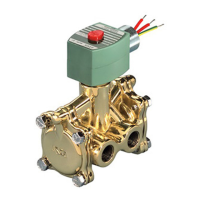Page 1 of 4 E291076 - 07/2019 All Rights Reserved. I&M V_6592_CA
©
ASCO Valve, Inc.
160 Park Avenue, Florham Park, New Jersey 07932 www.emerson.com
I&M V_6592_CA
Installation & Maintenance Instructions
3-WAY SOLENOID VALVES
NORMALLY CLOSED AND NORMALLY OPEN OPERATION
3/8” , 1/2” AND 3/4” NPT
SERIES
8316
NORMALLY OPEN
UNLATCHED
(CYL)
A
P
(PRESS)
LATCHED
(CYL)
A
E
(EXH)
P
(PRESS)
NORMALLY CLOSED
(CYL)
A
E
(EXH)
P
(PRESS)
LATCHED
(CYL)
A
E
(EXH)
P
(PRESS)
NOTICE: See separate solenoid installation and maintenance
instructions for information on: Wiring, Solenoid Temperature, Causes
of Improper Operation, and Coil Replacement.
DESCRIPTION
Series 8316 are 3-way, diaphragm-operated solenoid, pilot-controlled
valves. Valves are made of brass with only four moving parts: a core
assembly, two diaphragm assemblies and a disc holder sub-assembly.
Valves may be provided with a general purpose, explosionproof/watertight
solenoid enclosures.
dry inert gas and non-lubricated air service.
OPERATION
Normally Open
Solenoid De-energized:
Normally Closed
Solenoid De-energized:
Flow Diagrams
IMPORTANT: A minimum operating pressure dierential of 10 psi is
required; however, valve vents to 0 psi.
Manual Operator
Manual operator allows manual operation when desired or during an
electrical power outage. To operate valve manually, rotate manual operator
stem clockwise 180
solenoid is energized. Rotate manual operator stem counterclockwise 180
before operating valve electrically.
INSTALLATION
personnel.
Temperature Limitations
or as limited by by hazardous location (explosive atmosphere) solenoid
8316nd 120
separate solenoid instruction sheet provided for ambient temperature.
Positioning
This valve is designed to perform properly when mounted in any position.
However, for optimum life and performance, the operator movement should
be mounted vertical and upright to reduce the possibility of foreign matter
in the catalog number must be mounted with the solenoid vertical and upright.
Mounting
Refer to Figure 1 for mounting bracket (optional feature) mounting
dimensions.
Piping
only. If applied to valve threads, the compound may enter the valve and
aligning piping. When tightening the pipe, do not use valve or solenoid as a
lever. Locate wrenches applied to valve body or piping as close as possible
to connection point.
To ensure proper operation of the valve,the pressure and exhaust lines must
on the nameplate must be maintained between pressure and exhaust at the
this minimum pressure during shifting. To check pressure during shifting,
install a pressure gauge in the pressure piping as close to the valve as possible.
IMPORTANT: To protect the solenoid valve, install a strainer or lter,
suitable for the service involved in the inlet side as close to the valve as
possible. Clean periodically depending on service conditions. See ASCO
Series 8600 and 8601 for strainers.
Flow Controls (Speed or Metering Devices)
Flow control valves may be added to control cylinder speed. If used, these
valve and the cylinder.
IMPORTANT: Do not install ow controls (speed or metering devices)
or any type of restrictive device in either the Pressure “P” (inlet) or
Exhaust “E” (outlet) ports of the valve. Restricting either of these lines
may cause valve malfunction.
MAINTENANCE
WARNING: To prevent the possibility of death,
personal injury or property damage, turn o electrical
power, depressurize valve, and vent uid to a safe area
before servicing the valve.
AVERTISSEMENT: Pour éviter tous danger de mort,
de blessure grave ou de dommage matériel, avant
d’intervenir sur la vanne, couper le courant, purger la
vanne dans une zone sécurisée.
Cleaning
cleanings will vary depending on the medium and service conditions.
In general, if the voltage to the coil or solenoid is correct, sluggish valve
In the extreme case, faulty valve operation will occur and the valve may fail
Preventive Maintenance
•
material as possible.
• While in service, the valve should be operated at least once a month to
ensure proper opening and closing.
• Depending on the medium and service condition, periodic inspection
of internal valve parts for damage or excessive wear is recommended.
Thoroughly clean all parts. If parts are worn or damaged, install a
UNLATCHED
E
(EXH)

